Struggling to find the perfect material to elevate your interior and exterior designs?
With so many options, it’s easy to feel overwhelmed and uncertain about the best choice for timeless elegance and modern appeal.
Travertine is the answer. In this article, we explore 9 stunning travertine trends for 2024 that will transform your space with sophistication and style.
1. Large Format Travertine Tiles

Large-format travertine tiles are emerging as a prominent trend for 2024. They offer a sleek and modern aesthetic that significantly enhances the spaciousness of any area. Typically measuring 24×24 inches or larger, these tiles feature fewer grout lines, resulting in a seamless and cohesive look that visually expands the space.
The visual appeal of large-format travertine tiles lies in their ability to showcase the natural beauty of the stone. The larger surface area highlights the travertine’s unique patterns and variations, creating a more striking impact than smaller tiles.
Additionally, the reduced number of grout lines enhances the sense of space, making rooms appear larger and more open. This is particularly advantageous in smaller spaces, where maximising the perception of space is essential.
The modern elegance of large format tiles aligns with contemporary design trends, offering a clean, minimalist look that complements residential and commercial interiors.
However, the installation of large-format travertine tiles requires careful consideration. Proper subfloor preparation is crucial to ensure a level surface, as uneven subfloors can lead to potential cracking. Due to the size and weight of these tiles, professional installation is recommended to achieve a flawless finish and avoid alignment issues.
In terms of applications, large-format travertine tiles are ideal for living areas, such as living rooms and open-plan spaces, where they create a unified and expansive look. They also enhance the luxurious feel of bathrooms and kitchens while providing durability and ease of maintenance.
2. Travertine Feature Walls
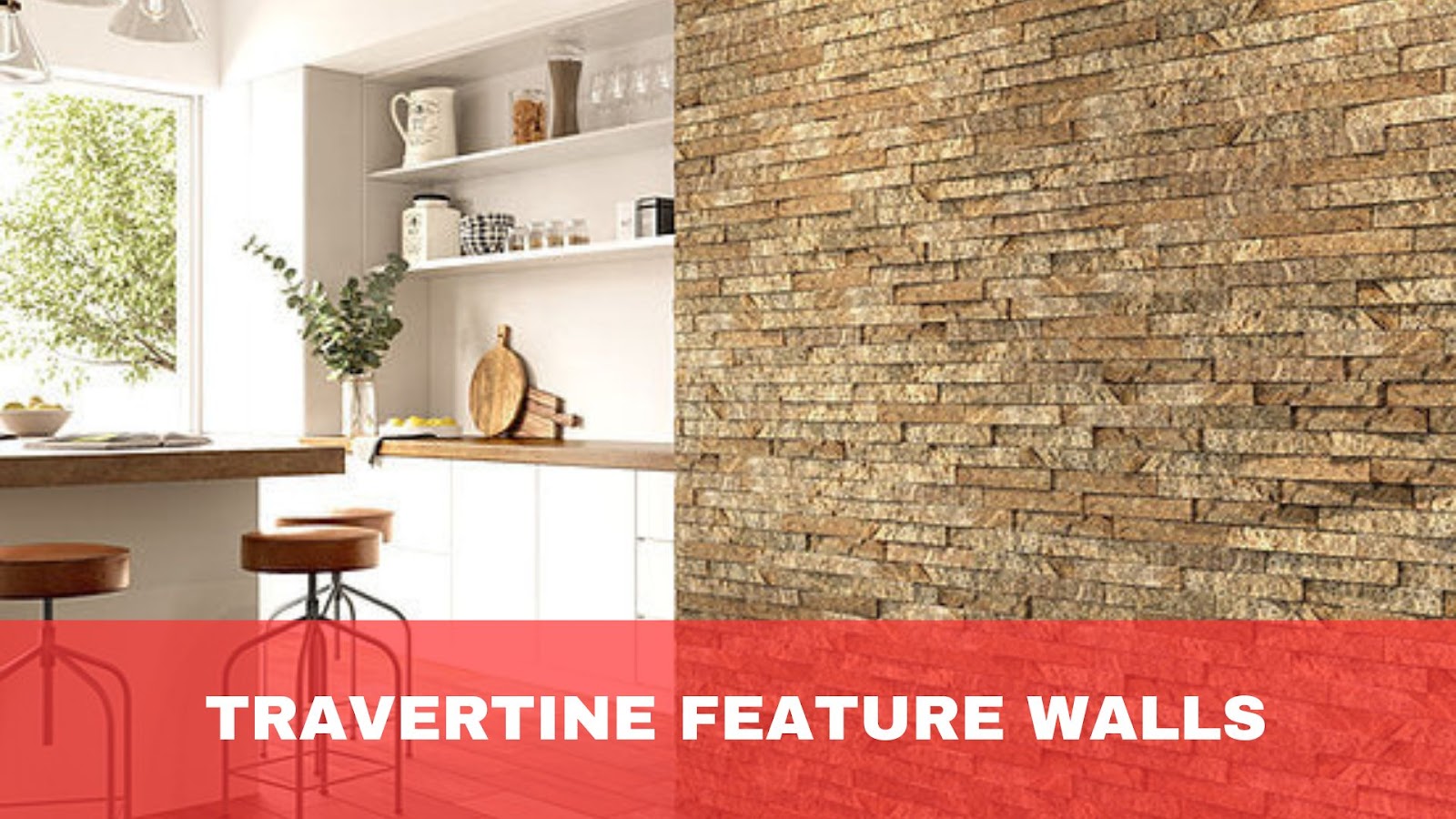
Travertine feature walls are becoming increasingly popular in 2024 as a bold design statement that adds natural elegance and texture to any space. These walls transform ordinary interiors into extraordinary showcases of natural beauty.
The aesthetic appeal of travertine lies in its unique patterns and warm tones, creating a visually stunning focal point. Each piece of travertine boasts distinct veining and colouration, ensuring a one-of-a-kind feature wall that stands out in any room.
The natural texture of travertine adds depth and dimension, making the space feel more dynamic and exciting. The variation in tile thickness and surface finish can create a 3D effect, further enhancing the wall’s visual impact.
Travertine feature walls are incredibly versatile, complementing various interior styles—from rustic and traditional to modern and minimalist. They can be incorporated into living rooms, bedrooms, bathrooms, and exterior facades.
However, the installation of travertine feature walls requires careful preparation. Proper wall preparation is crucial to ensure the travertine tiles adhere securely; the surface must be clean, dry, and level. Due to the weight and natural variations in travertine, professional installation is recommended to achieve a precise and attractive finish.
In terms of applications, travertine feature walls are perfect for living rooms, where they create a striking centrepiece behind a fireplace or TV.
In bathrooms, adding a travertine feature wall in the shower or behind the vanity enhances the luxurious feel of the space. Travertine can also be used for exterior feature walls, offering a sophisticated and durable option for outdoor living areas.
3. Mixed Finish Surfaces
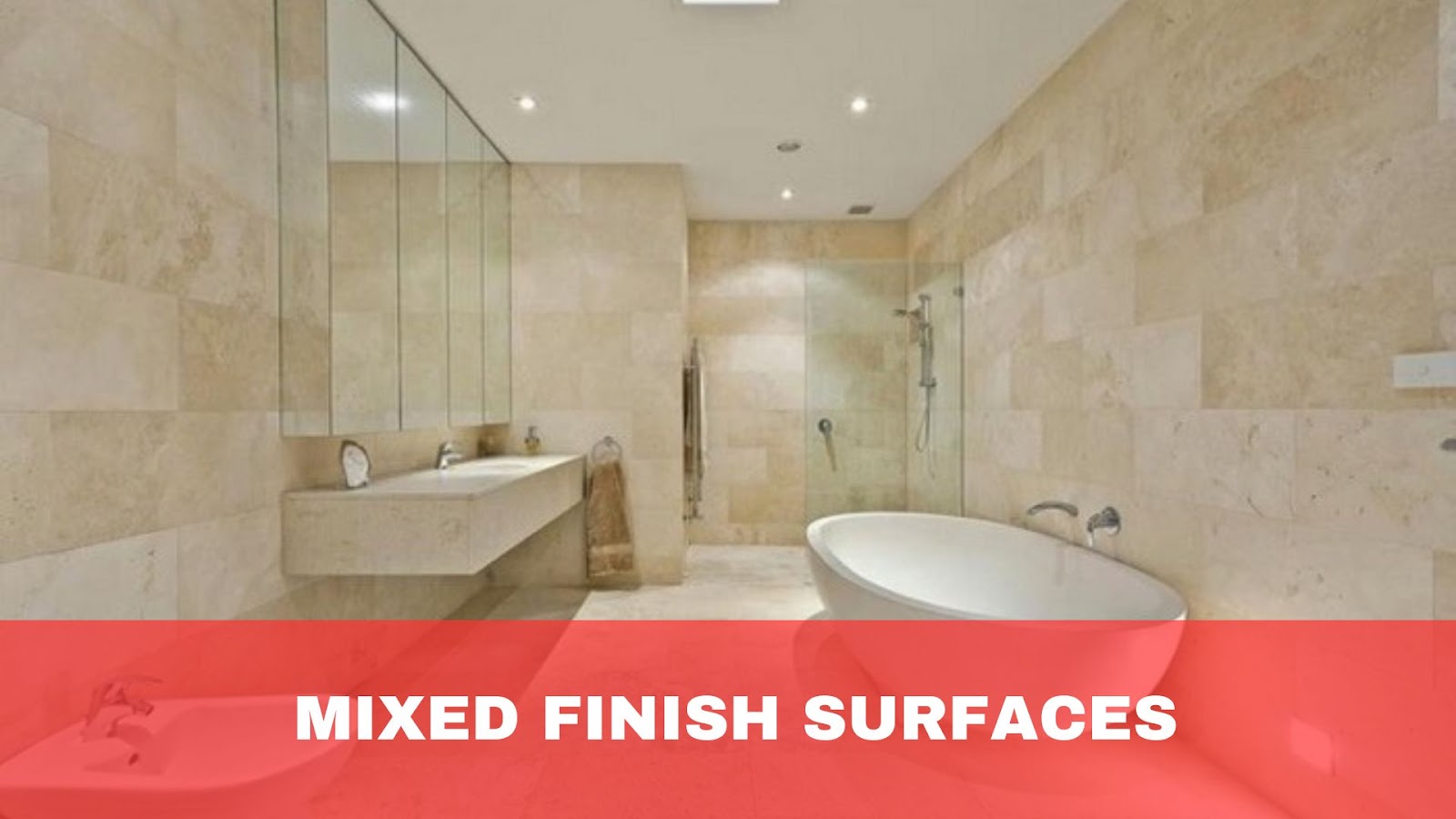
Mixed finish surfaces are a prominent trend in 2024, offering a sophisticated way to enhance travertine installations’ visual and tactile appeal. This approach combines different finishes, such as honed, polished, and tumbled, within the same surface area to create a dynamic and textured look.
The visual interest generated by mixing finishes adds depth and character to travertine surfaces. The contrast between smooth, polished sections and rougher, tumbled areas creates a captivating interplay of light and shadow, making each installation unique.
This trend showcases travertine’s versatility and natural beauty, allowing for personalised design expressions that stand out in any space. Additionally, combining different textures enhances the tactile experience, making surfaces more engaging to the touch. This is particularly appealing in spaces where interaction with the material is frequent, such as countertops or flooring.
However, the successful implementation of mixed-finish surfaces requires careful design planning. Achieving a harmonious balance between different finishes is crucial, as the mixed finishes need to complement other elements in the space. Professional expertise is often necessary to ensure smooth transitions between finishes, enhancing the overall visual appeal.
Regarding applications, mixed finish travertine tiles on floors create a unique and engaging surface, ideal for high-traffic areas like entryways and living rooms.
Using mixed finishes on wall cladding can transform a plain wall into a stunning focal point, perfect for feature walls or backsplashes. Incorporating mixed finishes into countertops or vanities adds a luxurious touch to kitchens and bathrooms, elevating the overall aesthetic.
4. Travertine in Minimalist Designs

Travertine is becoming a cornerstone in minimalist design trends for 2024, offering a perfect blend of natural beauty, subtle colour variations, and unique texture that complements serene, uncluttered spaces.
Its organic look enhances minimalist spaces by providing a warm, earthy feel without overwhelming the simplicity of the design. The neutral tones of travertine blend seamlessly with minimalist colour palettes, making it an ideal material for creating environments that embody the essence of minimalism.
While minimalist designs often focus on simplicity, travertine’s natural texture and veining add visual interest and depth, preventing spaces from looking too sterile. Additionally, travertine’s durability makes it a practical choice for high-use areas in minimalist homes, such as floors, walls, and countertops, ensuring both longevity and aesthetic appeal.
When incorporating travertine into minimalist designs, it is important to focus on clean lines and subtle details. To maintain the minimalist aesthetic, ensure that travertine tiles or slabs are installed with clean, straight lines. Consider using large-format tiles to reduce grout lines and create a seamless look.
Opting for honed or matte finishes enhances travertine’s natural, understated beauty, aligning with minimalist principles. Subtle applications, such as a feature wall, a simple backsplash, or an uncluttered countertop, allow travertine to shine without overwhelming the space.
Regarding applications, travertine flooring in minimalist homes offers a sleek, uninterrupted surface that enhances the sense of space and tranquillity. In bathrooms, using travertine for walls, floors, and vanities creates a spa-like retreat with clean lines and a calming ambience.
In living spaces, travertine can be incorporated into feature walls or fireplace surrounds, adding a touch of elegance and warmth to minimalist interiors.
5. Outdoor Travertine Pavers

Outdoor travertine pavers are emerging as a popular choice for 2024. They offer a perfect blend of durability, elegance, and natural beauty. These pavers are ideal for various outdoor applications, making them a versatile option for homeowners looking to enhance their exterior spaces.
Travertine is renowned for its durability, withstanding heavy foot traffic, harsh weather conditions, and the test of time. Its natural strength makes it an excellent choice for outdoor areas, ensuring long-lasting performance. Travertine’s aesthetic appeal lies in its natural hues and patterns, which add a sophisticated and timeless look to any outdoor space.
The warm, earthy tones of travertine blend seamlessly with natural landscapes, creating a harmonious and inviting environment. Another notable benefit is that travertine pavers remain cool to the touch, even in direct sunlight, making them comfortable for bare feet and ideal for poolside areas and patios.
Travertine pavers are particularly well-suited for patios, where they create a luxurious and inviting space perfect for outdoor entertaining and relaxation. Their non-slip surface and cool touch make them a safe and stylish option for pool decks, enhancing safety and aesthetics.
Additionally, travertine pavers are an excellent choice for garden paths and walkways, adding a touch of elegance while providing a durable, long-lasting surface.
When installing travertine pavers, it’s important to ensure proper base preparation to prevent shifting and settling over time. A high-quality sealer will protect the travertine from stains and weathering, enhancing its natural colour. Using edge restraints helps maintain the integrity and shape of the paved area, preventing the pavers from spreading or moving.
Regular cleaning is essential for maintenance to keep the pavers free of dirt and debris. At the same time, periodic sealing should be done every few years to maintain their appearance and protect them from the elements.
6. Travertine Mosaic Patterns
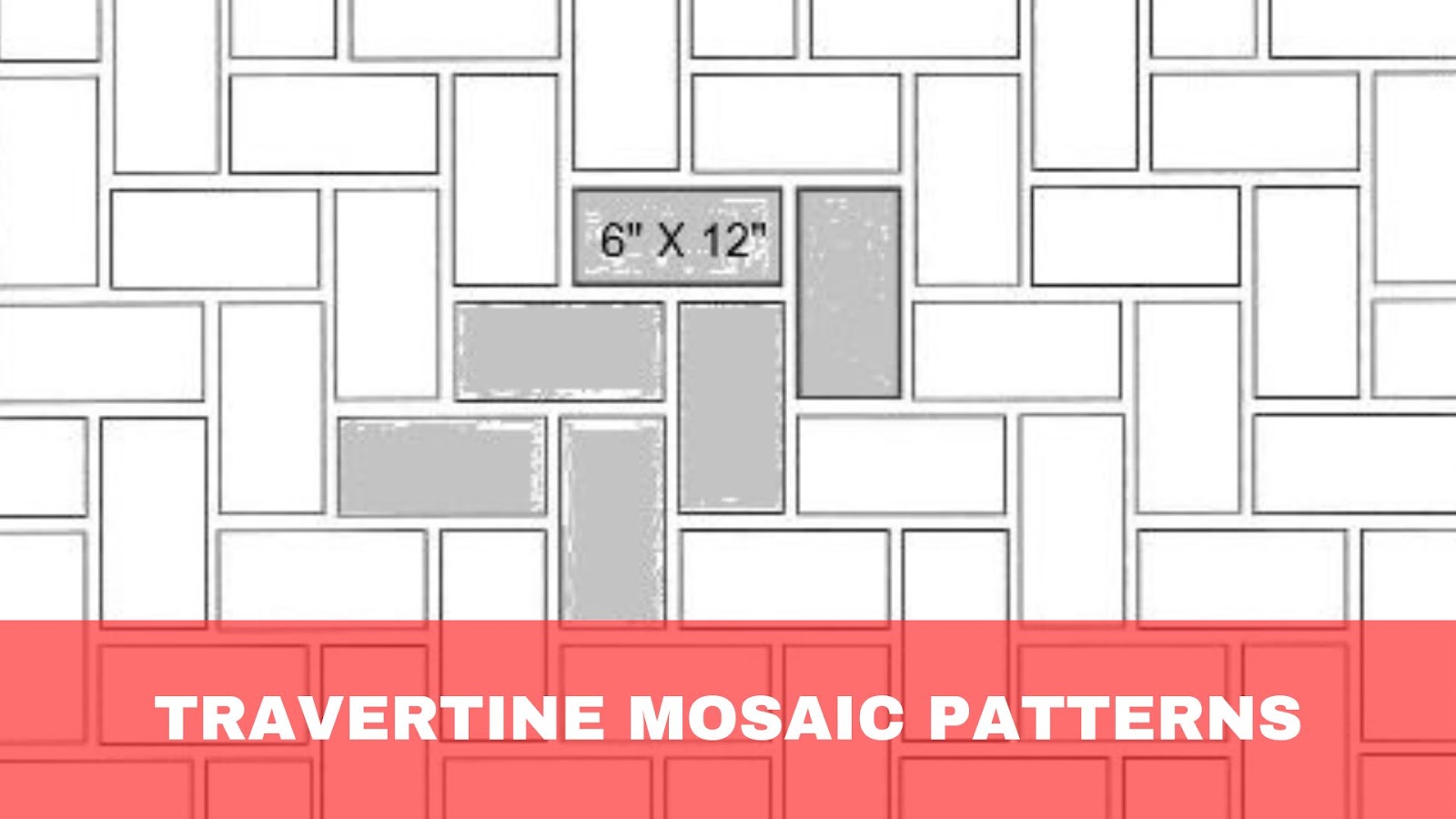
Travertine mosaic patterns are poised to be a standout trend in 2024, bringing intricate and artistic designs into residential and commercial spaces. These mosaics offer a unique way to incorporate travertine’s natural beauty and texture into various settings, making them a visually stunning option for any interior.
Travertine mosaics provide a visually stunning option, with their intricate patterns and natural colour variations adding depth and character to any space. Their versatility is another key advantage, as they are available in a wide range of patterns and sizes, allowing for customisation to fit any design vision, whether classic or contemporary.
Like all travertine products, mosaics are durable and long-lasting, making them suitable for high-traffic areas and ensuring they retain their beauty over time.
Travertine mosaics can be used in various applications to create striking visual effects. They are ideal for accent walls in living rooms, bathrooms, or entryways, where they serve as a focal point that enhances the overall design.
In kitchens and bathrooms, travertine mosaics are perfect for backsplashes, providing a stylish and easy-to-clean surface that complements various design styles. They are also well-suited for flooring designs, particularly in bathrooms and showers, where their textured surface adds beauty and slip resistance.
When designing with travertine mosaics, consider how they can contrast with or complement other materials in the space. For example, combining them with larger travertine tiles or different natural stones can create a harmonious design.
The selection of patterns is also essential; classic herringbone or basket weave patterns work well in traditional spaces, while geometric or abstract designs may be better suited for modern interiors. The choice of grout colour is another critical consideration, as neutral grouts blend seamlessly while contrasting grouts can highlight the mosaic pattern.
Due to their intricate designs, travertine mosaics require precision installation. Careful and precise installation is crucial to ensure the mosaics align correctly and achieve the desired effect. Additionally, sealing the mosaics before and after installation is important to protect against stains and moisture, especially in wet areas like bathrooms and kitchens.
7. Travertine with Bold Colours
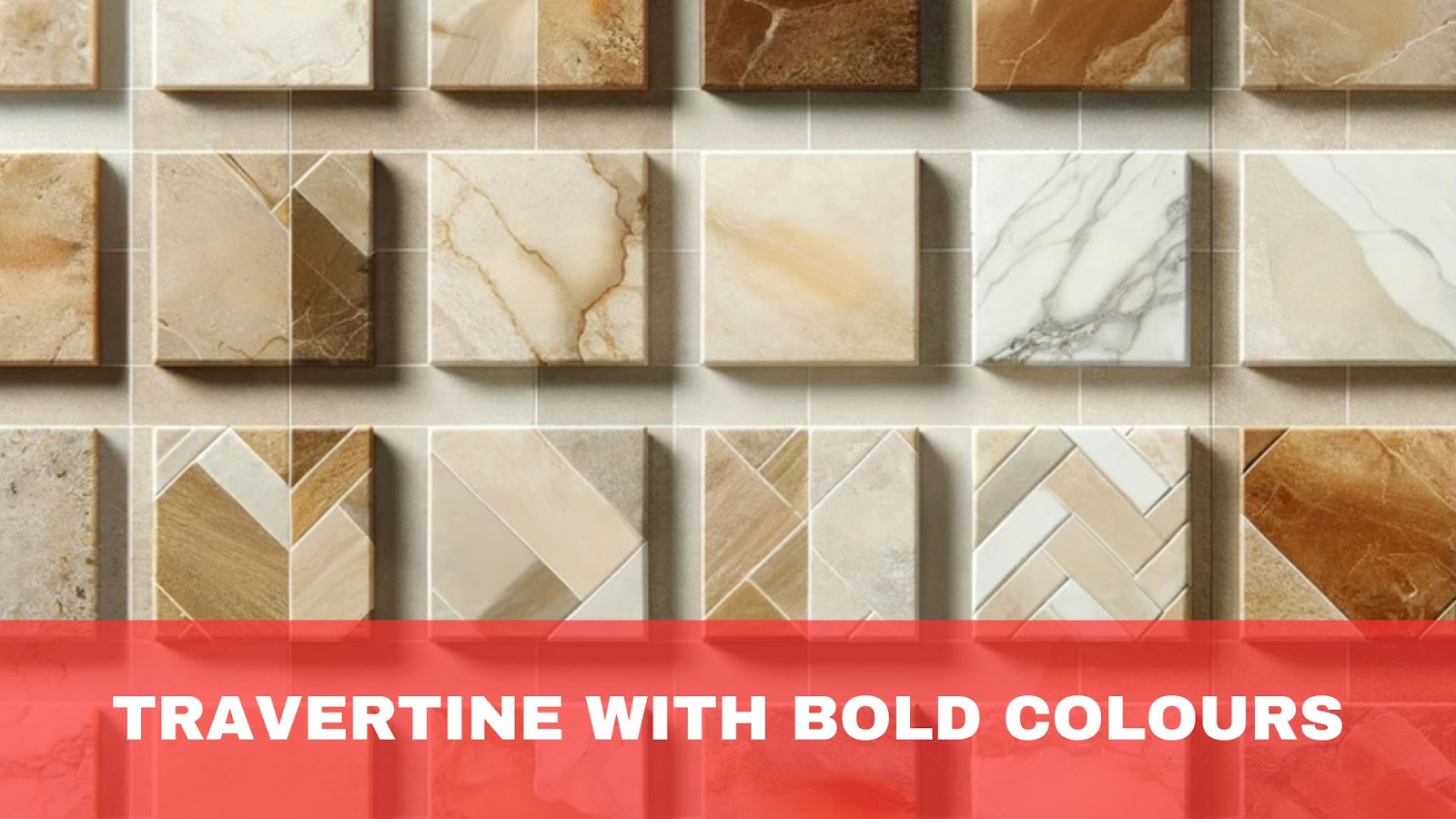
Travertine with bold colours is set to be a significant trend in 2024, pushing the boundaries of traditional travertine aesthetics. While travertine is known for its neutral hues, innovative treatments and finishes bring vibrant colours into the mix, transforming this classic material into a modern design statement.
Boldly coloured travertine makes a striking visual statement, adding energy and personality to any space. The vibrant colours can create focal points or accentuate specific areas within a design, making them versatile enough to complement or contrast with existing decor.
Available in various colours, from deep blues and greens to rich reds and golds, coloured travertine offers endless design possibilities. Despite the bold colours, travertine’s natural texture and veining are preserved, blending modern aesthetics with the timeless appeal of natural stone.
In terms of applications, bold-coloured travertine is perfect for feature walls in living rooms, offices, or commercial spaces, creating dramatic backdrops that draw attention.
In bathrooms and kitchens, coloured travertine can be used for countertops, backsplashes, or shower walls, adding a vibrant touch to these functional spaces. For flooring, bold-coloured travertine can make a statement in entryways, hallways, or large open spaces, setting the tone for the entire design.
To incorporate bold-coloured travertine effectively without overwhelming the space, it’s important to balance these striking colours with neutral elements. Pairing coloured travertine with white, grey, or beige tones can create a harmonious look, while using it as an accent—such as in a backsplash or feature wall—can add interest without overpowering the room.
Proper lighting is also key to enhancing the vibrancy of coloured travertine, ensuring the colours appear vivid and rich.
Given the unique nature of coloured travertine, professional installation is recommended to achieve the best results. This ensures precise cuts and seamless integration with other design elements. Additionally, coloured travertine should be sealed properly to maintain its colour and protect it from stains and moisture, especially in high-traffic or wet areas.
8. Sustainable Travertine
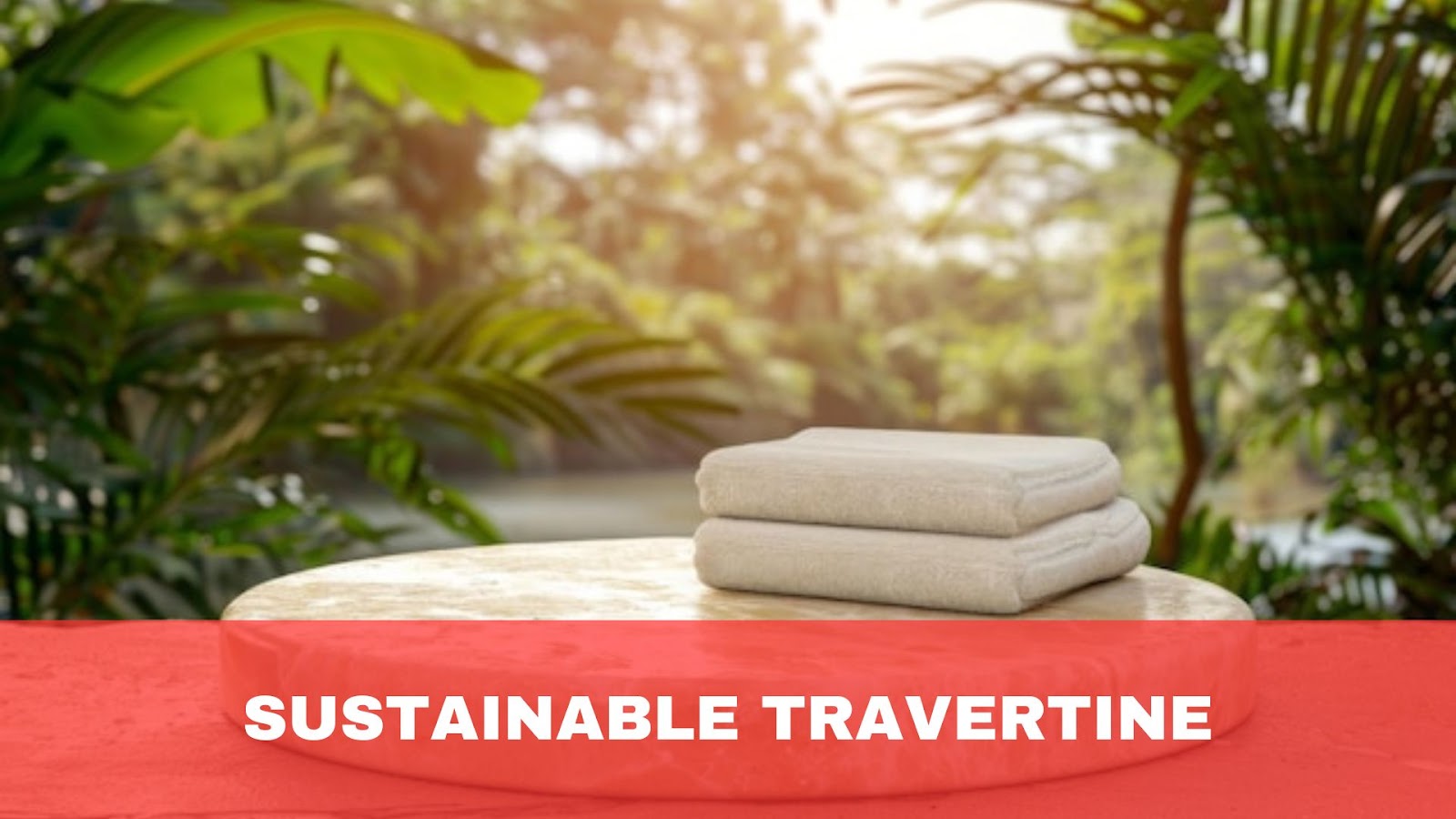
In 2024, sustainable travertine is gaining significant traction as environmentally conscious design becomes a priority for homeowners and designers alike. This trend emphasises using travertine sourced and processed with minimal environmental impact, aligning with the growing demand for sustainable building materials.
Eco-friendly sourcing is a key benefit of sustainable travertine, as it is sourced from quarries that adhere to strict environmental regulations, ensuring minimal disruption to natural landscapes.
This approach helps preserve ecosystems and reduces the carbon footprint associated with stone extraction. Additionally, the production process for sustainable travertine focuses on minimising waste, with advanced techniques allowing for the use of smaller or irregular pieces that would otherwise be discarded, maximising resource efficiency.
Travertine’s inherent durability also contributes to its sustainability. Its long lifespan means it doesn’t need to be replaced frequently, reducing the overall environmental impact over time. When properly maintained, travertine can last for decades, making it a sustainable choice for long-term projects.
Sustainable travertine is well-suited for green building projects seeking LEED certification or other eco-friendly standards. It contributes to a project’s overall sustainability goals. It can be used in interior and exterior designs, from flooring and wall cladding to outdoor patios and facades, offering aesthetic appeal and environmental benefits.
To maximise the sustainability of travertine in design, embrace its natural finish to highlight its organic beauty and reduce the need for additional treatments that may have environmental impacts.
Pairing sustainable travertine with other eco-friendly materials, such as reclaimed wood or recycled metal, can create cohesive and environmentally responsible designs. Additionally, sourcing travertine from local quarries whenever possible can further reduce transportation emissions and support local economies.
Proper installation is essential for ensuring the longevity and sustainability of travertine. Ensure the travertine is installed by professionals who understand sustainable practices, including appropriate sealing and placement, to enhance durability and longevity.
Regular maintenance, such as sealing and cleaning with eco-friendly products, will help preserve the stone’s appearance and structural integrity, ensuring it remains a sustainable choice.
9. Travertine in Contemporary Settings
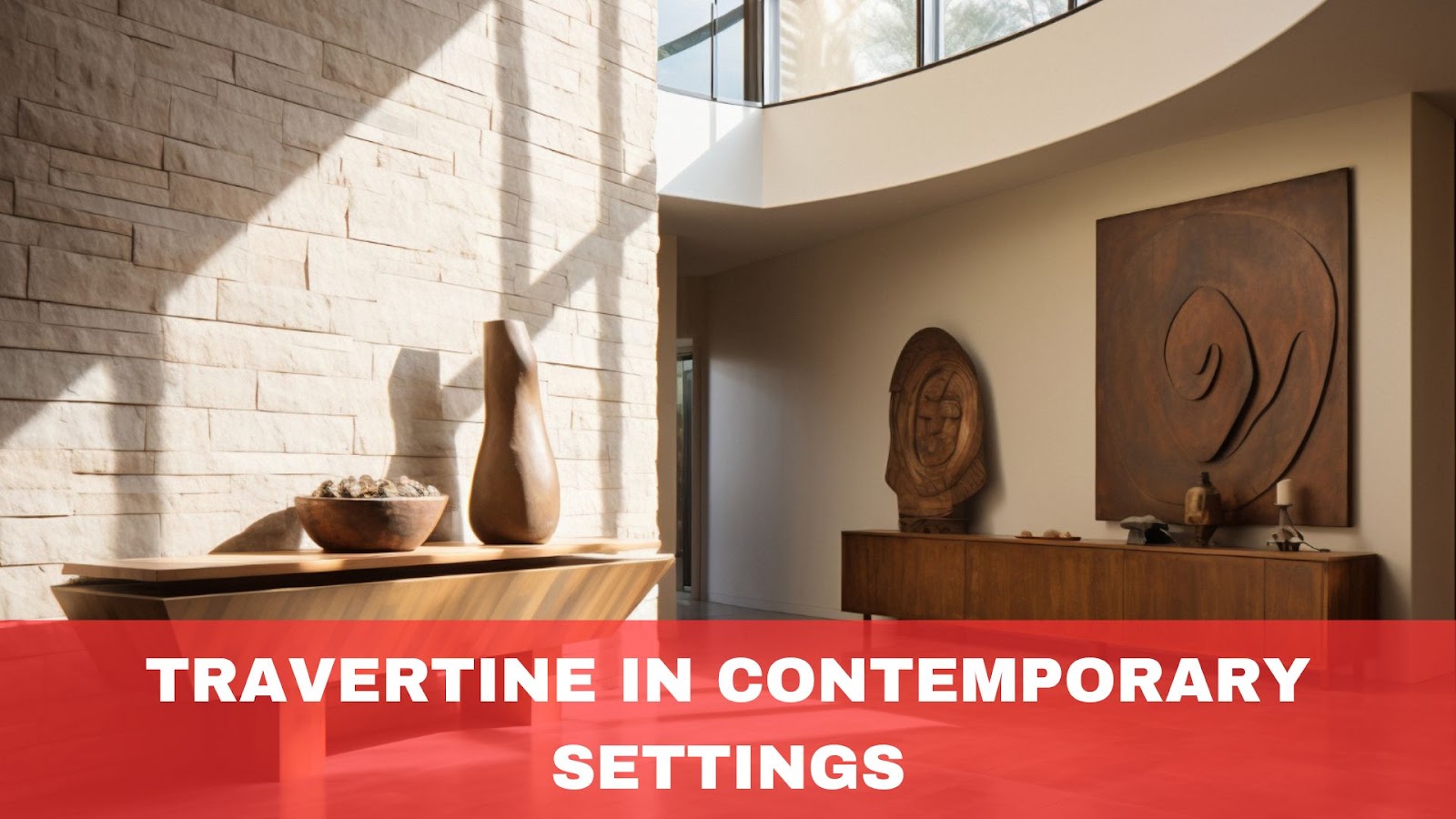
Travertine’s timeless appeal is finding new life in contemporary settings, where its natural elegance complements modern design aesthetics. Its versatility and unique textures make it an ideal choice for contemporary interiors and exteriors, adding sophistication and durability to these spaces.
Travertine’s natural patterns and subtle colour variations add a touch of sophistication to contemporary spaces, blending seamlessly with minimalist and modern designs. Its sleek and neutral tones make it highly versatile, allowing it to be used in various applications, from flooring and wall cladding to countertops and bathroom surfaces.
This adaptability makes travertine suitable for residential and commercial projects, enhancing the overall aesthetic while ensuring long-lasting quality. Known for its durability, travertine is a practical choice for high-traffic areas in contemporary settings, providing both beauty and resilience.
In contemporary design, travertine can be effectively used in open-plan living spaces. Its flooring enhances flow and continuity, creating a cohesive and elegant look.
Feature walls clad in travertine can serve as striking focal points, highlighting the natural beauty of the stone in modern interiors. Additionally, travertine’s moisture resistance makes it ideal for contemporary bathrooms and kitchens, which can be used for countertops, backsplashes, and shower walls, adding functionality and style.
When incorporating travertine into contemporary designs, it’s essential to focus on clean lines and simple layouts. Avoid overly ornate details to let the stone’s natural beauty shine through, and pair it with a neutral colour palette to maintain a sleek and modern look.
Mixing travertine with other materials such as glass, metal, and wood can create a balanced and dynamic design, enhancing the visual interest and texture of the space.
For optimal results, professionals should install travertine to ensure precise cuts and proper alignment, which are crucial in contemporary designs.
Regular sealing and maintenance are also essential to protect travertine surfaces from stains and preserve their pristine appearance. Using pH-neutral cleaners will help maintain the stone’s natural beauty over time, ensuring it remains a standout feature in any contemporary setting.
Conclusion
In 2024, travertine continues to inspire with its versatility and elegance. From bold colours to sustainable choices, these trends can transform your space.
Ready to elevate your design with travertine? Explore our curated selection and start your project today for a timeless, contemporary look. Contact us now for a consultation.












